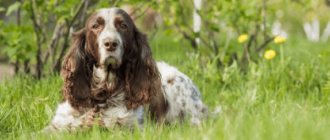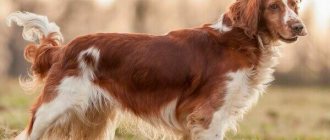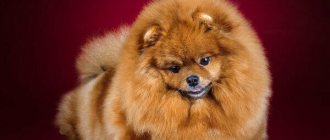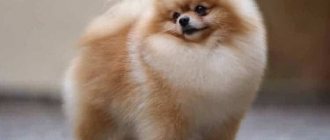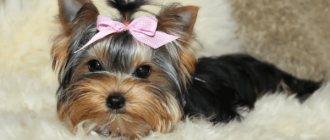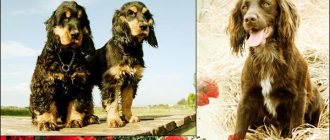Spaniels are the general name for a large group of breeds, which primarily includes hunting dogs, but also includes decorative and even dwarf pets.
The Mini Cocker Spaniel is a beautiful hunting dog of miniature size, considered the smallest among all gun breeds.
Despite the fact that they have not lost the hunting instincts of their ancestors, nowadays miniature cockers are much more often used as companions and family pets than for their original purpose.
They are also popular as participants in exhibitions and sports competitions, for example, freestyle skiing.
After all, in addition to their beautiful and impressive appearance, these dogs are very smart, quick-witted and willing to learn new skills.
Are there mini cocker spaniels?
There is no breed called a mini cocker spaniel . Usually, when it comes to the smallest cockers, we mean dogs of the American Cocker Spaniel breed.
All advertisements for the sale of mini cocker spaniels are either fraudulent, when breeders try to sell ordinary English or American cockers under the guise of a rare breed, or the puppies offered suffer from a genetic disease called dwarfism.
It is also likely that puppies sold as Miniature Cocker Spaniels were simply deliberately underfed by the breeder so that they could be sold for more than standard-sized puppies .
Breeds from the same group
- Australian (kangaroo) greyhound
- Australian Terrier
- Austrian Shorthaired Pinscher
- Azawakh
- Ainu (Hokkaido Inu, Ainu-ken, Hokkaido dog, Hokkaido)
- Akita Inu
- Alopekis
- Alaskan Malamute
- American Blue Gascony Hound (Big and Blue)
- American Indian dog
- American Cocker Spaniel
- American Staffordshire Terrier
- American Toy Terrier (American Toy Fox Terrier)
- American Foxhound (American Foxhound)
- Amur Laika (Indana)
- Anatolian Shepherd
- English Beagle
- English cocker spaniel
- English Pointer (Pointer)
- English Setter (Laverack)
- English Foxhound (Foxhound, American Foxhound)
- Dogo Argentino (Argentine Mastiff, Dogo Argentino)
- Artois Hound (Chien d'Artois)
- Ariège marriage (Ariege pointer, artesien Norman, bracque de Toulouse)
- Afghan Aboriginal Hound (Bakhmul)
- Afghan Hound (Afghan)
- Africanis (lion dogs)
- African hairless dog
- Affen pinscher (monkey pinscher)
- Bakhmul (Afghan Aboriginal Hound)
- Banjar Greyhound
- Basenji (Nyam Nyam Terrier)
- Basset Hound
- Batak Spitz (Pomeranian dog, Batak dog of Sumatra)
- Bedlington Terrier (Rothbury Terrier)
- Beagle Harrier
- Billy (Biya)
- Dogue de Bordeaux (Dogue de Aquitaine, French Mastiff)
- Bosnian Barrack (Bosanski Gonjic, Bosnian Rough-haired Hound, Ke
- Fila Brasileiro (Fila Brasileiro, Brazilian Mastiff, Brazilian Mol
- Breton fawn basset (Breton Basset, Red Breton Basset)
- Bourbon braque
- Buryat-Mongolian wolfhound (Hottosho)
- Wachtelhund (German Spaniel, German Quail Dog)
- Welsh Springer Spaniel
- Welsh Terrier
- Hungarian Greyhound (Magyar Agar)
- Hungarian Vizsla (Vizsla, Hungarian Shorthaired Pointer, Hungarian
- East Siberian Laika
- West Highland White Terrier (West Highland White Terrier, White Highland
- Hanoverian Hound
- Smooth Fox Terrier
- Blue Gascony Griffon
- Hamilton's Hound (Hamiltonstövare)
- Greyhound (English greyhound)
- Greenland dog (Greenland dog)
- Greek hare hound (Hellenic Iknilatis)
- Griffon cortalsa (French Wirehaired Pointer Griffon)
- Jack Russell Terrier
- Jämtland Laika (Emthund, Yemthund, Yamthund, or Swedish Elkhound,
- Wire Fox Terrier
- West Siberian Laika
- Golden retriever
- Irish Water Spaniel
- Irish Wolfhound
- Irish Setter
- Irish Terrier
- Spanish Water Dog (Perro De Acqua Español)
- Italian Segujo (Italian Hound)
- Kai (Brind dog, Kai, Tora Inu, koshu-tora, kai-ken, deer hunting
- Cane Corso Italiano
- Keeshond, Wolfspitz
- Cairn Terrier
- Kerry Blue Terrier
- Kyrgyz Shepherd
- Kishu (Kishu-inu, Kishu-ken)
- Clumber Spaniel
- Cocker Spaniel
- Kromforlander
- Labrador Retriever
- Laika
- Latvian hound
- Levesque
- Lesser Swiss Hound
- Lesser Vendean Basset Griffon (Petit Basset Griffon)
- German Wirehaired Pointer (Drathaar)
- German Hunting Terrier (German Jagdterrier)
- Nova Scotia Retriever (Nova Scotia Duck Retriever, Norwich Terrier
- Norwegian Elkhound (Norwegian Elkhound)
- Norwegian Lundehund (Norwegian Puffin Husky, Norsk Lundehund, Lun
- Norwegian Elghound black
- Ogar (Polish Ogar)
- Otterhound (Otter Hound)
- Parson Jack Russell Terrier
- Pitbull
- Podenco Canario
- Pointer (English Pointer)
- Polish Hound (Polish Ogar)
- Polish ogar
- Portuguese Water Dog (Cao De Acqua)
- Portuguese Podengo
- Poodle
- Rhodesian Ridgeback
- Romanian Mioritic Shepherd Dog
- Russian hunting spaniel
- Russian Spaniel
- Russian-European Laika
- Samoyed dog (Samoyed, Samoyed Spitz)
- Saint-Germain Bracque
- Serbian Hound (Balkan Hound, Yugoslav Hound)
- Stabihon (stabihunzhe, stebihun)
- Taigan (Kyrgyz Greyhound)
- Thai Ridgeback
- Dachshund
- Whippet
- Pharaoh Hound (Pharao Hound, Old Egyptian Greyhound)
- Finnish Hound (Tricolored Finnish Hound, Suomenajokoira)
- French white and orange hound
- Harrier dog
- Cirneco dell'Etna (Sicilian Greyhound)
- Shar Pei
- Silky Windhound (Silky Whippet, Windhound, Small Borhound
- Shikoku (Shikoku, Kochi-ken, Mikawa Inu)
- Styrian hound (Styrian marriage, Styrian rough-haired highland
- Epagnole Pont Audemer
- Airedale
Origin story and what it looks like in the photo
Spaniels, whose homeland is Spain, were brought to Britain back in the 12th century AD.
Already by the 14th century, the breed was divided into water and land spaniels. With the former they hunted water game, and with the latter they hunted land game, and it was from a small variety of land spaniels that cockers originated. They hunted with them mainly small birds, mainly woodcocks.
In 1620, cockers were brought to the New World, and from that time a new stage in the development of this breed began. However, at this time it was not yet possible to talk about their American variety as a separate breed.
Even in the second half of the 19th century, when English cockers were already officially recognized and took part in exhibitions, American-bred dogs continued to be crossed with them, although by that time they were already somewhat different from the original breed in their appearance.
The ancestor of the American cocker is considered to be a dog named Obo the Second, born in the USA in August 1882 and distinguished by its very small size for dogs of that time: his height was only 25 cm at the withers.
Despite the fact that Obo the Second was very different from modern cockers in physique and had a very stretched body, he was considered very good in conformation for his time and became an outstanding sire.
At the beginning of the 20th century, standards were developed on both sides of the Atlantic and even then it became clear that the American variety of cockers was very different from the English one.
In 1935, the final division took place: English-type dogs were recognized as standard cockers, and American ones were excluded from breeding.
However, in 1946, the AKC recognized the American variety as a separate breed, after which international recognition of these dogs took place..
Reviews
Vladimir, 28 years old, Moscow: “Our spaniel is already 3 years old. This is the sweetest and kindest creature. The dog does not bark, has never shown aggression, and is very active. You have to walk her for several hours a day and constantly brush her. She is friendly to guests and immediately becomes the life of the party.”
Natalya, 30 years old: “In our family, the fawn spaniel is the children’s favorite. They happily walk and play with him, and there are no conflicts. There were problems with my ears, but I managed to cure them. He loves to eat and is playful.”
Ruslan, 25 years old: “For me, the American spaniel is a companion on a bike ride. For him, running next to each other for several kilometers is not a problem. I trained him since childhood, so there are no difficulties, but I couldn’t stop running after birds.”
Character traits
Miniature Cockers are lively, energetic and playful dogs that are intelligent, quick-witted and inquisitive.
They are very friendly towards people, become very attached to their owners and are great with children..
At the same time, if desired, such a pet can be raised into a wonderful hunting assistant, which, despite its small size, will track, fly, and even bring shot game to its owner no worse than other spaniels.
Mini Cockers are also suitable as sports dogs and, although disciplines such as dragging loads are unacceptable for them, many American Cockers show excellent results in agility, freestyle and other sports that require agility and artistry.
Expert opinion
Kozhevin Semyon Kirillovich
Expert dog handler.
“The Mini Cocker Spaniel, despite its small size, is agile, agile and energetic. This is a dog that is equally suitable as a pet or a working dog. However, mini-cockers are not often used nowadays for their original purpose, since many hunters are not satisfied with the labor-intensive care of their coat, and therefore they prefer shorter-haired breeds. But at the same time, thanks to their spectacular appearance and friendly disposition, American cockers are popular as pets and show dogs.”
Learning ability
In terms of learning ability, the “star” character can again play a cruel joke. The Cocker must be constantly praised, but scolding is prohibited. The dog will understand the reproachful tone, but will simply demonstratively not react to the scream.
On the scale of intelligence and intelligence, a cocker deserves five points, but with reservations. We need to find an approach to this proud handsome man. He must be the best and the first in everything - the owner’s praise is the best incentive for training.
To punish a cocker, you don’t need to scold or shout at him, just ignore the dog. It’s not there for you, that’s all. Spaniels are very worried about their owner's inattention and will try to immediately correct their mistake, which caused your displeasure.
Advantages and disadvantages
pros:
- Beautiful appearance.
- Very smart and quick-witted.
- They are loyal to their owners and love to please them.
- Friendly attitude towards people.
- They get along well with children.
- Not aggressive towards other pets.
- Playfulness and energy.
- Small convenient size.
Minuses:
- Quite labor-intensive and expensive grooming and the need for haircuts.
- Needs long walks.
- Quite gluttonous and prone to obesity.
- Excessive trust in strangers.
- Hunting instincts can cause a pet to escape if a mini cocker rushes to chase a bird or, for example, a neighbor's cat.
Nutrition
The diet and composition of the diet of this breed does not imply any subtleties. It is important that the diet is nourishing and varied. The food should include different types of meat, poultry, fish (boiled), cereals, vegetables and cottage cheese.
You can feed your pet food you prepare yourself, or give them commercial food. Puppies need six meals a day. As you get older, the number drops to twice a day. There is no need to overfeed your pet. This leads to obesity.
Dimensions, weight and other distinctive features
| Options | Data |
| Height | Males - 38-40 cm Bitches - 35-36 cm |
| Weight | Males – 11-15 kg Bitches – 8-10 kg |
| Frame | Strong and compact, with a strong, straight back and a moderately broad, well-developed chest. |
| Head | Harmonious and proportional to the body, with a well-defined stop. The length of the muzzle, shaped like a square, should be approximately half the total length of the head. |
| Ears | Long, hanging, set low - in line with the eyes. |
| Eyes | Large, expressive, always dark, almond-shaped or round. The expression of the eyes is benevolent and meek. |
| Nose | Depending on the color, it can be either black or brown. |
| Neck | Elongated, graceful, slightly curved. |
| Limbs | Strong and strong, without signs of disintegration. |
| Tail | Previously, it was docked in puppyhood, but now it can be left at natural length, since this does not contradict the breed standard. |
| Wool | Straight or slightly wavy. Quite short on the head, but long on the ears and body. At the bottom of the body and on the paws it forms a so-called skirt. The coat is silky and pleasant to the touch, without the slightest signs of coarseness or, conversely, excessive fluffiness and cottoniness. |
| Color | It can be either one-color (fawn, red, brown, black), or two-color or three-color. Black and tan and brown American cockers are also found. |
The edge of the dog's ear, if extended in length, should reach the edge of the nose with its tip.
Mating
The first mating is carried out at the age of one and a half years. The ideal moment is 8-10 days of estrus. The mating takes place on the territory of the male dog. Spaniels are best bred in the morning after a walk, but before feeding. During mating, it is recommended to hold the bitch by the ears or head. This must be done carefully, but firmly. A day after the first mating, a control mating is carried out.
Pregnancy and childbirth
On average, cocker pregnancy lasts 9 weeks. If the litter is large, signs become obvious by 7 weeks. If the female carries 1-2 puppies, the pregnancy may go unnoticed.
Before giving birth, detailed veterinary advice should be obtained. It is best to call a doctor at home.
Childbirth can last from several hours to a day. In the first 10-12 days after the birth of puppies, the temperature in the room should be maintained at 28 degrees. Then it is gradually reduced to 20.
Lifespan
The average lifespan of miniature cockers is 13-15 years.
However, dogs of this breed may be susceptible to the following diseases::
- Dysplasia
- Cataract
- Progressive retinal atrophy
- Corneal dystrophy
- Glaucoma
- Hemolytic anemia.
- Allergy
- Otitis and other inflammatory diseases of the ears.
- Dilactation cardiomyopathy.
- Epilepsy
The life expectancy and health status of a pet primarily depends on its heredity and conditions of detention..
Dog health
Spaniels have good immunity and excellent health. With proper nutrition and proper care, they can live up to sixteen years. The most common diseases:
- chronic hepatitis; hypothyroidism;
- otitis;
- nephrolithiasis;
- melanoblastoma;
- atopy;
- ulcerative keratitis;
- food allergies;
- progressive retinal degeneration;
- catarct;
- glaucoma;
- epilepsy;
- hip dysplasia.
Allergies to food appear after a certain time after changing the diet. Mainly associated with a specific type of protein (chicken and beef, for example). Fecal incontinence is common. Often there are problems with the eyes, for example, prolapse of the lacrimal gland.
Care and maintenance
Caring for the coat of these dogs is quite difficult. Miniature cockers need bathing no more than once a week. In this case, it is necessary to use special cosmetics that will not only make your pet’s fur clean, but also improve its quality.
Brush your cocker regularly to prevent tangling of the coat . In addition, dogs of this breed require periodic haircuts.
Due to the fact that American Cockers can be susceptible to allergies, it is recommended to use hypoallergenic shampoos and conditioners when washing them.
Your pet’s long ears need to be inspected every day and cleaned if dirty..
The visible part of the ear canal of a miniature cocker is cleaned with cotton swabs and a special lotion, and the inside of the ear is wiped with a damp cloth.
IMPORTANT!
The dog's eyes can be wiped with cotton swabs soaked in a special eye cleaner.
The claws are trimmed with a nail clipper as they grow, that is, when their tips begin to curl inward.
The Miniature Cocker's teeth also need care: they need to be periodically cleaned and the condition of the gums monitored.
It is recommended to clean them using special treats or toys, but if plaque is not removed by these methods, then you can brush the animal’s teeth with a brush and toothpaste for dogs.
In the same case, if hardened plaque appears on the teeth, you should contact a veterinary clinic to have it removed.
Proper feeding
You can feed mini cocker spaniels natural food or ready-made food no lower than super-premium, or better yet, holistic-class. At the same time, if the dog is prone to allergies or obesity, you should opt for a special dietary food.
When feeding natural food, the basis of the diet should be cut into pieces and scalded raw lean meat.
You should add chopped vegetables (raw or boiled), as well as fermented milk products, such as cottage cheese or kefir.
When feeding your pet naturally, it is also necessary to add vitamins and mineral supplements to your pet’s food..
Interesting Facts
There are many interesting facts about the cockapoo breed. Here are a few of them:
- Cockapoos are hypoallergenic dogs, so they can live in an apartment or house with people prone to allergies.
- A cockapoo named Alfie won the title of "Dog with a Smile" in a competition run by Penguin Books. According to the jury, this animal is constantly smiling. Many breeds competed for this award, but the 9-month-old Cocker Poodle was awarded the award.
- The breed is popular not only in America; its qualities are also appreciated in Sweden, Australia and Great Britain.
The breed is ideal for participation in beauty contests
Cockapoo is a person's best friend and cheerful companion. He is able to empathize with his owner and at the same time try to cheer him up, which cannot but be appreciated.
How to choose?
First of all, you should decide on the gender, color and quality of the future pet. If you decide to buy a show-class cocker, and gender does not matter, then it is better to opt for a male, as they look more impressive in the rings.
However, it should be taken into account that girls are more affectionate and obedient, and therefore, if there are children in the house, it is better to buy a bitch.
You should only buy a dog in a kennel or from a breeder, since purchasing a cocker on the market, and even without the puppy having documents of origin, can be fraught with the purchase of a mestizo, and not a purebred spaniel.
When choosing a baby from a litter, you need to carefully examine it to make sure that its appearance meets the standard requirements, and that its eyes, nose, ears and skin are clean and healthy.
CAREFULLY!
It is not recommended to purchase a puppy that shows anger towards people, cowardice or nervousness.
Also, you should not buy babies that are too small in size, since these puppies are often either undernourished or suffer from a hereditary disease such as dwarfism or, in other words, dwarfism.
Choosing a puppy
In order not to buy a beautiful mongrel for a lot of money, you need to take the choice of a future companion seriously. You should pay attention to the ears: normally they are healthy, without odor or signs of inflammation. The transition from forehead to muzzle is clearly expressed.
At 2 months, a spaniel puppy begins to develop a wide, strong back, short but muscular legs, smooth fur, shiny eyes, and a moist and clean nose.
The optimal age for weaning from the mother and changing place of residence is 2-3 months.
